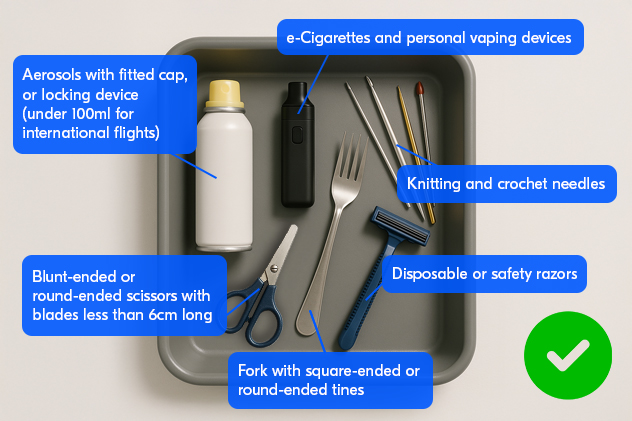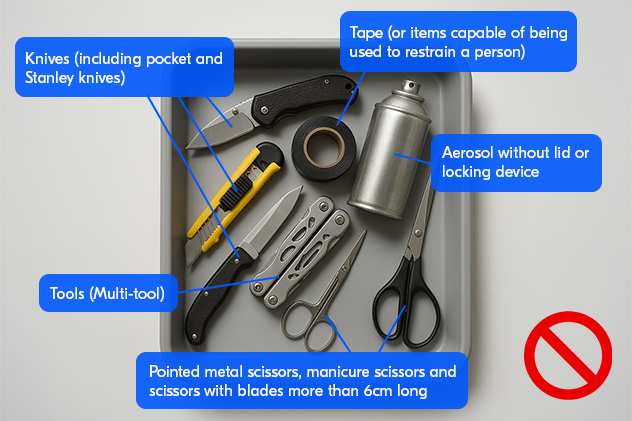What’s allowed with carry-on airline baggage?

Frequent flyers will regularly tell you that carry-on baggage is a non-negotiable whenever they’re in the air. It spares passengers the uncertainty of lost checked baggage, saves time at both ends and ensures packing efficiency.
However, it’s not all skittles and rainbows with the humble carry-on cabin bag. Especially if you’re asked to part ways with something you cherish.
This happened to your humble correspondent recently when asked to surrender my beloved skipping rope – a travel staple for the past 15 years, and one that never piqued the interest of airport security before.
In this instance, according to security officials at Alice Springs airport, the rope posed as a potential hazard because it was longer than a certain length and ‘could be used to choke someone’. This is despite thousands of laptop chords of a similar length being passed through Australian airport security each day.

AI generated image illustrating a skipping rope at airport security checkpoint.
The episode highlighted the inconsistency of carry-on allowances within Australia but also reinforced the risk you may take by carrying items on the plane rather than underneath it. Skipping ropes are not listed anywhere as a banned item, however the security officer in question took issue with it being carried on-board.
So, with a healthy degree of user discretion, here’s the Open Road’s guide to what’s allowed and what’s prohibited in terms of airline carry-on baggage.
What is the maximum weight of a carry-on bag on a plane?
As a general rule, airline passengers are allowed to carry one 7kg carry-on bag (measuring up to 56cm long, 36cm wide and 23cm deep), or two smaller pieces of luggage totalling 14kg in weight (each piece must not exceed 10kg) and measuring no larger than 48cm long by 34cm wide and 23cm deep.
Those allowances are for Virgin Australia and Jetstar domestic bookings. If you’re travelling Qantas, the permissible single carry-on bag allowance climbs to 10kg, while other allowances mirror rival airlines.
Across all airlines, the general rule is that if you’re travelling with two carry-on items, the larger bags go into the overhead locker above while small bags are placed under the seat in front of you.
Moreover, weight allowances change if you’re flying internationally or with other airlines. There are separate measures in place for garment bags and personal items, too, which means it’s always worth checking an airlines website before flying.
For example, collapsible strollers are also permitted for infants under 2 years, in addition to the accompanying adult’s carry-on baggage. Ditto a small bag with food and nappies.
Airport security screening is enforced by the Australian Government, with the Department of Home Affairs setting the broad requirements. Ultimately, individual airport security has the final say on what’s allowed in carry-on and what isn’t.
Why are there weight limits to carry-on baggage in the first place?
Ah, yes. This is an age-old argument. There are no weight restrictions on passengers, so why do they apply to carry-on bags?
According to Virgin Australia, “Carry-on baggage that exceeds the carry-on weight and size limits are not permitted because they pose a safety risk and may cause injury to our guests and team members”.
What items are allowed in carry-on baggage?
Since there are apparent discrepancies in individual airport security screening (see above), please take this advice as a loose guide.
But in general terms, airline passengers are permitted to carry:
- Aerosols with fitted cap, or locking device (under 100ml for international flights)
- e-Cigarettes, personal vaping devices
- Fork with square-ended or round-ended tines and a non-detachable handle that is round-ended
- Blunt-ended or round-ended scissors with blades less than 6cm long
- Knitting and crochet needles
- Disposable or safety razors

AI generated image illustrating some items allowed in airline carry-on baggage
What items aren’t allowed in carry-on baggage?
This topic is ultimately down to the discretion of individual security officer, but as a general rule, you cannot include the following items in your carry-on baggage:
- Knives (including pocket and Stanley knives)
- Tape (or items capable of being used to restrain a person)
- Aerosol without lid or locking device
- Tools (Multi-tool)
- Pointed metal scissors, manicure scissors and scissors with blades more than 6cm long.
In addition, passengers are prohibited from carrying inflight travel accessories or devices which attach to aircraft seats, can be inserted between seats or block access to seat rows or aisles. In other words, leave your ‘bed box’ or ‘leg hammock’ at home.

AI generated image illustrating some items not allowed in airline carry-on baggage
The caveat used by airlines is that due to the number of items passing through security, it is not possible to list them all. “Security screening officers are responsible for ensuring security standards are met and have the final say about what items are permitted,” one airline writes.
For the full list of items individually listed by the Department of Home Affairs, please see the bottom of this story or visit their website.
How much powder, liquid, aerosol or gel can I take in carry-on luggage?
Flights within Australia are not subject to restrictions on how much powder, liquid, aerosols and gels you can carry on board, according to airlines.
So in other words, no, you are not required to empty the contents your water bottle before going through security.
For international flights, however, guests are permitted to carry liquids, aerosols, and/or gels (with caps) in containers with a maximum capacity of 100ml each. These items are to be carries in a clear resealable plastic bag (usually available from the airport security) and screened at the checkpoint.
You'll also need to present any forms of powders you may be travelling with in your carry-on baggage. There are no restrictions on the carriage of organic powder materials such as baby formula, protein powder and most cosmetics. However inorganic powders, which include salt, sand, some talcum products, must not exceed 350ml in volume or 350g in weight. Other powders exempt from the restriction include medical or therapeutic products and cremated remains (ashes).
What items are banned from airport carry-on luggage?
According to the Australian Government’s Department of Home Affairs, the following items are blacklisted from carry-on baggage:
- Axes, hatchets or similar
- Box cutters
- Crampons
- Darts
- Drills
- Ice axes and ice picks
- Ice skates
- Knives, including leather working knives
- Knife-like items (whether or not made of metal) strong enough to be used as a weapon
- Meat cleavers
- Metal cutlery
- Open/straight razors
- Rock climbing equipment such as pitons, hooks, hammers and bolts
- Saws
- Scalpels
- Screwdrivers, crowbars, hammers, pliers and wrenches
- Ski poles
- Utility knives
- Letter openers
- Bodkins
- Pointed metal scissors, manicure scissors and scissors with blades more than 6cm long
- Razor blades
- Hypodermic needles (whether or not attached to syringes) without proof that they are medically necessary for your use or the use of another person under your care
- Baseball, softball and cricket bats and any similar item used in sport
- Billiard, pool or snooker cues
- Hockey and lacrosse sticks and any similar item used in sport
- Golf clubs
- Pieces of wood, metal or any other material big enough to threaten a person with
- Aerosol containers, including cans of spray paint, unless they are for personal or medical use and have a cap or locking mechanism
- Petrol and any other flammable liquid
- Fireworks
- Toy caps
- Cable ties
- Handcuffs
- Flares
- Gun powders
- Daggers, flick-knives, star knives, shuriken throwing irons and stars
- Harpoons
- Sabres, swords and swordsticks and similar things
- Spears
- Disabling and incapacitating chemicals, gases or sprays, such as mace, pepper or capsicum spray, tear gas, acid sprays and animal-repellent sprays
- Stun guns
- Anything that can be used to administer an electric shock, such as cattle prods and tasers
- Billy clubs and leather billies
- Blackjacks
- Martial arts equipment such as knuckle dusters, clubs, coshes, rice flails and nunchucks, kubatons and kubasaunts
- Night sticks and batons
- Ballistic knives and similar devices designed to discharge a projectile by means of an explosive or other propellant or mechanism
- Blow pipes






